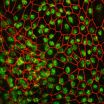"The cutting edge of serrated polyps: a practical guide to approaching and managing serrated colon polyps"
Colonoscopy with detection and removal of colonic polyps is the foundation of colorectal cancer screening and surveillance programs. However, different types of colonic polyps have different malignant potential and recommendations for removal and follow-up surveillance varies depending on the type of polyp.
The most common colonic polyps include the conventional adenomas (tubular, tubulovillous, and villous adenomas which are precancerous polyps) and serrated polyps. Serrated polyps account for as many as 36 percent of colonic polyps. Initially the hyperplastic (benign) polyp was the only recognized serrated polyp. Today, the term serrated polyp is recognized as a general term describing a heterogeneous family of polyps with distinct molecular underpinnings, clinicopathologic features, and a varied capacity for malignant potential. In this review article from Christina A. Arnold, MD, Ohio State University, Columbus, and colleagues, the salient clinicopathologic features of serrated polyps and practical management recommendations are discussed.
The location and size of the serrated polyp are extremely helpful in determining the type of serrated polyp for the clinician and pathologist, therefore both should be documented. As conventional endoscopic techniques alone are unable to reliably diagnose polyps, histologic evaluation remains the criterion standard for accurate diagnosis. The most important type of serrated polyp is the sessile serrated adenoma/polyp (SSA/P). The prevalence of SSA/Ps ranges from one percent to nine percent of all colonic polyps. SSA/Ps are most commonly found in women, unlike the male-predominant conventional adenomas. Risk factors for SSA/Ps (and conventional adenomas) include older age, sex, smoking, and obesity; the latter two risk factors also independently predict large (>10 mm) SSA/Ps. Importantly, patients with SSA/Ps are more likely to have a greater polyp burden and synchronous and metachronous neoplastic lesions than patients without SSA/Ps. In addition, the progression from SSA/P with cytologic dysplasia to invasive carcinoma (cancer) may be relatively rapid. Complete removal of polyps, particularly small, flat, right-sided polyps (such as SSA/Ps) is challenging and associated with the development of interval carcinoma, likely through missing or incompletely removing the precursor lesion.
In September 2012, the U.S. Multi-Society Task Force on CRC (colorectal cancer) released updated guidelines for colonoscopy surveillance with a much-needed expansion on the management of serrated polyps. In addition to the U.S. Multi-Society Task Force guidelines, an expert consensus opinion was separately published in 2012 based on an expert panel discussion and review of advancements and insights in the serrated polyp literature. The 2012 guidelines have placed serrated polyps >10 mm or with cytologic dysplasia in the same surveillance category as high-risk adenomas with a three-year surveillance interval. The guidelines also advise a one-year surveillance interval for serrated polyposis (formerly "hyperplastic polyposis") a phenotypically variable condition associated with increased serrated polyps and an up to nearly 40 percent risk of colorectal cancer.
The expert consensus opinions recommend at least five-year endoscopic surveillance intervals for first-degree relatives of patients with serrated polyposis, starting at age 40 or 10 years younger than the age at diagnosis of the affected relative. Among the key management recommendations discussed in the guide for approaching and managing serrated colon polyps is the removal of serrated polyps. Given the malignant potential and that SSA/Ps are most often flat with indistinct borders, complete endoscopic resection (removal) is critical. When SSA/P margins cannot be fully resected, residual tissue can be removed by cold forceps or burned by argon plasma coagulation, and close endoscopic follow-up is advised at less than one year per the updated guidelines.
"Prophylactic clip closure reduced the risk of delayed postpolypectomy hemorrhage: experience in 277 clipped large sessile or flat colorectal lesions and 247 control lesions"
Hemorrhage (bleeding) is the most common major complication of colonoscopic polypectomy (polyp removal). The risk of hemorrhage is associated with large polyp size, proximal location, and the use of anticoagulation. One approach to prevent delayed hemorrhage after colonoscopic polypectomy is closure of polypectomy sites with clips. No controlled study has yet been reported of the value of prophylactic clip closure for the group of polyps at highest risk of complications, namely, large sessile or flat colorectal lesions.
This retrospective report from Douglas K. Rex, MD, FASGE, and colleagues at the Indiana University Hospital, Indianapolis, describes the impact of prophylactic (preventive) clip closure on complications, primarily delayed postpolypectomy hemorrhage, in 277 large polypectomy sites that were completely or partially prophylactically closed, and 247 control polypectomy sites that were not closed with clips. These lesions were removed from 463 patients who had telephone follow-up at least 30 days after colonoscopy to ensure complete capture of complications.
This study's objective was to evaluate the effect of prophylactic clip closure of polypectomy sites after resection of large (≥ 2 cm) sessile and flat colorectal lesions. The study was performed at the tertiary care endoscopy unit at Indiana University Hospital. Patients with lesions 2 cm or larger who underwent endoscopic mucosal resection (EMR) performed by using low-power coagulation current between January 2000 and February 2012 participated in the study. Beginning in June 2006, polypectomy sites were prophylactically closed with clips when possible.
The main outcome measurements were delayed hemorrhage, postpolypectomy syndrome and perforation. There were 524 lesions 2 cm or larger in 463 patients, of which 247 (47.1 percent) were not clipped, 52 (9.9 percent) were partially clipped, and 225 (42.9 percent) were fully clipped. There were 31 delayed hemorrhages, two perforations, and six cases of postpolypectomy syndrome. The delayed hemorrhage rate was 9.7 percent in the not clipped group versus 1.8 percent in the fully clipped group. Multivariate analysis showed that not clipping, location proximal to the splenic flexure and polyp size were associated with delayed bleeding.
The researchers concluded that prophylactic clipping of resection sites after endoscopic removal of large (≥ 2 cm) colorectal lesions using low-power coagulation current reduced the risk of delayed postpolypectomy hemorrhage. A randomized, prospective trial of clipping large polypectomy sites is warranted.
Guideline
Also in the issue is the updated guideline "The role of endoscopy in the assessment and treatment of esophageal cancer."
###
About the American Society for Gastrointestinal Endoscopy
Since its founding in 1941, the American Society for Gastrointestinal Endoscopy (ASGE) has been dedicated to advancing patient care and digestive health by promoting excellence and innovation in gastrointestinal endoscopy. ASGE, with more than 12,000 members worldwide, promotes the highest standards for endoscopic training and practice, fosters endoscopic research, recognizes distinguished contributions to endoscopy, and is the foremost resource for endoscopic education. Visit http://www.asge.org and http://www.screen4coloncancer.org for more information and to find a qualified doctor in your area.
About Endoscopy
Endoscopy is performed by specially-trained physicians called endoscopists using the most current technology to diagnose and treat diseases of the gastrointestinal tract. Using flexible, thin tubes called endoscopes, endoscopists are able to access the human digestive tract without incisions via natural orifices. Endoscopes are designed with high-intensity lighting and fitted with precision devices that allow viewing and treatment of the gastrointestinal system.
END


